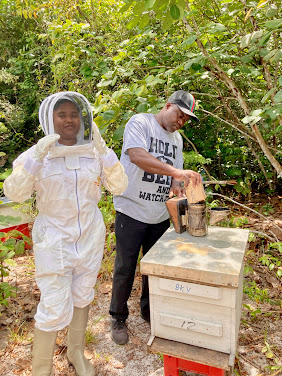From the Field: Organic Pesticide Formulation in Guyana
This post below comes from our Farmer to Farmer Team in Guyana:
On September 16, 2012 Mr. Sam Schaefer-Joel, a Product Review Coordinator of the Organic Materials Review Institute based in Oregon, USA, travelled to Guyana to help the Guyana F2F Field Team come up with appropriate recipes of home-made natural pesticides made primarily from locally available raw materials, such as neem and hot pepper. He also provided advice on how to use and how to store the natural pesticides.
Samuel, who is also a Master Gardener and Master Composter / Recycler and who had farmed for several years in Mexico and California, was most suited for this hands-on type of assignment. While in Guyana he visited several shadehouses and met with shadehouse operators in order to understand the production system as well as the types of pests that are common to that system.
Samuel’s main focus was to modify an existing natural pesticide made from locally available materials such as neem leaves, hot pepper and garlic. The aim was to produce a stable mixture using kitchen equipment. Hence, field staff were exposed to in-house mixing so as to come up with a recipe that was easy to follow and at the same time effective. A Training / Exposure Workshop was subsequently held and samples along with a one page recipe with instructions on application of the pesticide were distributed to shadehouse operators who attended. The objective is to test the effectiveness of the product. The vision is that in the future operators would make the pesticide for themselves or purchase it from others who may choose to set up a cottage industry.
To date many are using the natural pesticide and are seeing improvements in terms of reduction in leaf damage to crops. Through feedback from a sample of shadehouse operators who are piloting the use of this natural pesticide, F2F Field Officers are monitoring the results with a view to recommending any changes that may be required to the formula.
Thanks to Mr. Samuel Schaefer-Joel we have move one step closer to improving the quality of vegetables produced under the hydroponic shadehouse system.
+007.JPG) |
| Volunteer Samuel Schaefer-Joel with formulations of organic pesticides |
Samuel, who is also a Master Gardener and Master Composter / Recycler and who had farmed for several years in Mexico and California, was most suited for this hands-on type of assignment. While in Guyana he visited several shadehouses and met with shadehouse operators in order to understand the production system as well as the types of pests that are common to that system.
Samuel’s main focus was to modify an existing natural pesticide made from locally available materials such as neem leaves, hot pepper and garlic. The aim was to produce a stable mixture using kitchen equipment. Hence, field staff were exposed to in-house mixing so as to come up with a recipe that was easy to follow and at the same time effective. A Training / Exposure Workshop was subsequently held and samples along with a one page recipe with instructions on application of the pesticide were distributed to shadehouse operators who attended. The objective is to test the effectiveness of the product. The vision is that in the future operators would make the pesticide for themselves or purchase it from others who may choose to set up a cottage industry.
 |
| Sigmund McKenzie's seedlings benefit from organic pesticide |
Thanks to Mr. Samuel Schaefer-Joel we have move one step closer to improving the quality of vegetables produced under the hydroponic shadehouse system.


.png)

Comments
Post a Comment